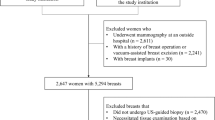Abstract
The purpose of this project was to determine whether Contrast Limited Adaptive Histogram Equalization (CLAHE) improves detection of simulated spiculations in dense mammograms. Lines simulating the appearance of spiculations, a common marker of malignancy when visualized with masses, were embedded in dense mammograms digitized at 50 micron pixels, 12 bits deep. Film images with no CLAHE applied were compared to film images with nine different combinations of clip levels and region sizes applied. A simulated spiculation was embedded in a background of dense breast tissue, with the orientation of the spiculation varied. The key variables involved in each trial included the orientation of the spiculation, contrast level of the spiculation and the CLAHE settings applied to the image. Combining the 10 CLAHE conditions, 4 contrast levels and 4 orientations gave 160 combinations. The trials were constructed by pairing 160 combinations of key variables with 40 backgrounds. Twenty student observers were asked to detect the orientation of the spiculation in the image. There was a statistically significant improvement in detection performance for spiculations with CLAHE over unenhanced images when the region size was set at 32 with a clip level of 2, and when the region size was set at 32 with a clip level of 4. The selected CLAHE settings should be tested in the clinic with digital mammograms to determine whether detection of spiculations associated with masses detected at mammography can be improved.
Similar content being viewed by others
References
Homer MJ: Mammographic Interpretation: A practical approach. New York, NY, McGraw Hill, 1991, pp 4–5
Rosenman J, Roe CA, Cromartie R, et al: Portal Film enhancement: Technique and clinical utility. Int J Radiat Oncol Biol Physics 25:333–338, 1993
Schmidt RA, Nishikawa RM: Clinical Use of Digital Mammography: The Present and the Prospects. J Digit Imaging 8:74–79, 1995 (suppl 1)
Shtern F: Digital mammography and related technologies: A perspective from the National Cancer Institute. Radiology 183:629–30, 1992
Feig SA, Yaffe MJ: Current status of digital mammography. Sem Ultrasound, CT and MR 17:424–443, 1997
Pisano ED, Chandramouli J, Hemminger BM, et al: Does intensity windowing improve the detection of simulated calcifications in dense mammograms? J Digit Imaging 10:79–84, 1997
Pisano ED, Chandramouli J, Hemminger BM, et al: The effect of intensity windowing as an image processing tool in the detection of simulated masses embedded in digitized mammograms. J Digit Imaging 10:174–182, 1997
Puff DT, Pisano ED, Muller KE, et al: A method for determination of optimal image enhancement for the detection of mammographic abnormalities. J Digit Imaging 7:161–171, 1994
McSweeney MB, Sprawls P, Egan RL: Enhanced image mammography. AJR Am J Roentgerol 140:9–14, 1983
Smathers RL, Bush E, Drace J, et al: Mammographic microcalcifications: Detection with xerography, screen film, and digitized film display. Radiology 159:673–677, 1986
Chan HP, Doi K, Galhorta S, et al: Image feature analysis and computer-aided diagnosis in digital radiography: I. Automated detection of microcalcifications in mammography. Med Phys 14:538–547, 1987
Chan HP, Vyborny CJ, MacMahon H, et al: Digital mammography ROC studies of the effects of pixel size and unsharp-mask filtering on the detection of subtle microcalcifications. Invest Radiol 22:581–589, 1987
Hale DA, Cook JF, Baniqued Z, et al: Selective digital enhancement of conventional film mammography. J Surg Onc 55:42–46, 1994
Yin F, Giger ML, Vyborny CJ, et al: Comparison of bilateral-subtraction and single-image processing techniques in the computerized detection of mammographic masses. Invest Radiol 28:473–781, 1993
Yin F, Giger M, Doi K, et al: Computerized detection of masses in digital mammograms: Analysis of bilateral subtraction images. Med Phys 18:955–963, 1991
Kallergi M, Clarke LP, Qian W, et al: Interpretation of calcifications in screen/film, digitized and wavelet-enhanced monitor-displayed mammograms: A receiver-operating characteristic study. Acad Radiol 3:285–293, 1996
Pizer S, Zimmerman JB, Staab EV: Adaptive grey level assignment in CT scan display. J Comput Assist Tomogr 8:300–305, 1984
Pizer SM: Psychovisual issues in the display of medical images, in Hoehne KH (ed): Pictoral Information Systems in Medicine. Berlin, Germany, Springer-Verlag, 1985, pp 211–234
Revesz G, Kundel HL, Graber MD: The influence of structured noise on the detection of radiologic abnormalities. Invest Radiol 9:479–486, 1974
Kundel HL, Revesz G: Lesion conspicuity, structured noise and film reader error. AJR Am J Roentgenol 126:1233–1238, 1976
Revesz G, Kundel HL: Psychophysical studies of detection errors in chest radiology. Radiology 128:559–562, 1977
MacMillan NA, Creelman CD: Detection theory: A user guide. Cambridge, England, Cambridge University Press, 1991, pp 135–136
Author information
Authors and Affiliations
Additional information
Supported by NIH PO1-CA 47982, NIH RO1-65583 and DOD DAMD 17-94-J-4345.
Rights and permissions
About this article
Cite this article
Pisano, E.D., Zong, S., Hemminger, B.M. et al. Contrast Limited Adaptive Histogram Equalization image processing to improve the detection of simulated spiculations in dense mammograms. J Digit Imaging 11, 193 (1998). https://doi.org/10.1007/BF03178082
DOI: https://doi.org/10.1007/BF03178082




